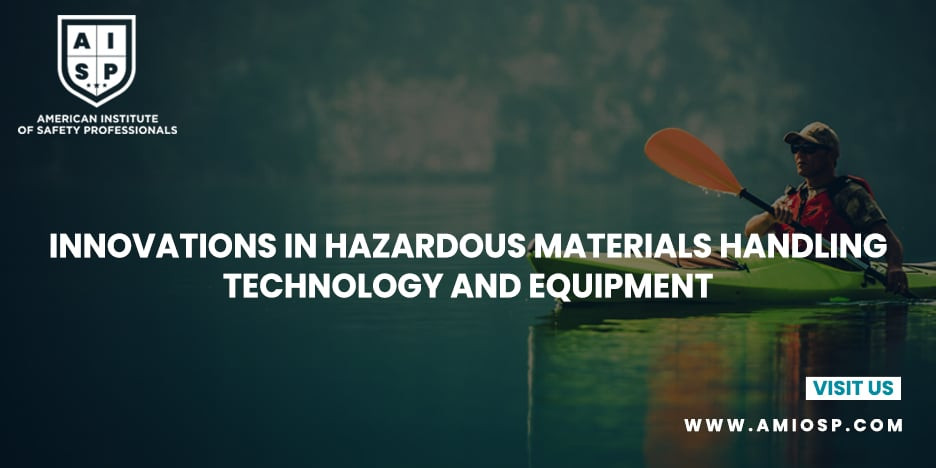Hazardous materials handling is a critical aspect of various
industries, including manufacturing, transportation, and healthcare. As
technology continues to advance, new innovations in hazardous materials
handling are revolutionizing the way organizations manage and mitigate risks
associated with these substances. In this blog post, we will explore some of
the latest advancements in technology and equipment that are improving hazardous
materials handling practices.
Introduction: The Importance of Innovation in
Hazardous Materials Handling
Effective handling of hazardous materials is crucial to
protect human health, ensure regulatory compliance, and prevent environmental
damage. Innovations in technology and equipment offer opportunities to enhance
safety, efficiency, and sustainability in hazardous materials management. By
adopting these advancements, organizations can stay at the forefront of best
practices and reduce the risks associated with handling hazardous materials.
Automation and Robotics
Automation and robotics have significantly transformed
hazardous materials handling by reducing human involvement in potentially
dangerous tasks. Some innovations include:
- Automated
Material Handling Systems: These systems use robotics and conveyance
technologies to transport, store, and handle hazardous materials. They can
minimize human exposure to hazardous substances and improve operational
efficiency.
- Remote
Monitoring and Control: Advanced sensor technologies and remote
monitoring systems enable real-time monitoring of hazardous materials
storage conditions, such as temperature, humidity, and gas levels. This
allows organizations to detect anomalies and take proactive measures to
prevent accidents.
- Robotic
Sampling and Analysis: Robots equipped with sampling and analysis
capabilities can collect and analyze hazardous materials samples,
eliminating the need for human intervention in potentially hazardous
environments.
Sensing and Detection Technologies
Sensing and detection technologies play a crucial role in
identifying and monitoring hazardous materials. Some notable advancements
include:
- Chemical
Sensors: Highly sensitive chemical sensors can detect and identify
hazardous substances in real time, helping organizations quickly respond
to leaks or releases.
- Wireless
Gas Detection: Wireless gas detection systems enable continuous
monitoring of gas levels in hazardous environments. These systems can
provide early warnings of potential leaks or accumulation of toxic gases.
- Smart
Tags and Labels: Smart tags and labels embedded with sensors and RFID
technology can track and monitor hazardous materials throughout the supply
chain. They provide real-time information on storage conditions, expiration
dates, and handling requirements.
Protective Equipment and Personal Safety
Innovations in personal protective equipment (PPE) enhance
the safety and well-being of workers involved in hazardous materials handling.
Some advancements include:
- Advanced
Respiratory Protection: High-performance respirators with improved
filtration capabilities and ergonomic designs offer enhanced respiratory
protection for workers handling hazardous materials.
- Smart
PPE: Smart PPE integrates sensor technologies to monitor vital signs,
detect exposure to hazardous substances, and provide alerts and
notifications to workers and supervisors.
- Augmented
Reality (AR) and Virtual Reality (VR): AR and VR technologies provide
immersive training experiences for hazardous materials handling, allowing
workers to practice handling procedures in a virtual environment before
working with actual hazardous materials.
Waste Management and Treatment
Innovations in waste management and treatment technologies
are essential for the safe disposal and treatment of hazardous materials. Some
advancements include:
- On-Site
Treatment Systems: Compact and portable treatment systems allow
organizations to treat hazardous waste on-site, reducing the need for
off-site transportation and minimizing the associated risks.
- Bioremediation:
Biological treatment methods, such as bioremediation, use microorganisms
to break down hazardous substances into non-toxic byproducts. This
environmentally-friendly approach offers a sustainable solution for
hazardous waste treatment.
- Advanced
Filtration and Separation Technologies: Innovations in filtration and
separation technologies enable efficient removal of hazardous substances
from liquids and gases, improving the effectiveness of treatment
processes.
Data Management and Analytics
The collection and analysis of data play a crucial role in
optimizing hazardous materials handling processes. Innovations in data
management and analytics include:
- Digital
Platforms: Cloud-based platforms allow organizations to centralize hazardous
materials data, including storage conditions, safety data sheets, and
compliance records. This facilitates easy access to critical information
and ensures regulatory compliance.
- Predictive
Analytics: Advanced analytics algorithms can analyze historical data
to identify patterns, predict potential hazards, and provide insights for
proactive risk mitigation.
- Integration
with the Internet of Things (IoT): Integration of hazardous materials
handling equipment with IoT technologies enables real-time data collection
and analysis, enhancing operational efficiency, and facilitating
predictive maintenance.
Conclusion: Embracing Innovation for Safer Hazardous
Materials Handling
Innovations in technology and equipment are transforming
hazardous materials handling, offering improved safety, efficiency, and
sustainability. Organizations that embrace these advancements can enhance their
hazardous materials management practices, reduce risks, and ensure compliance
with regulations. By staying abreast of the latest developments and investing
in innovative solutions, organizations can create a safer working environment,
protect human health and the environment, and position themselves as leaders in
the industry.












0 comments
No Comments